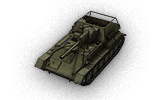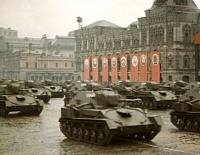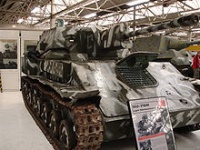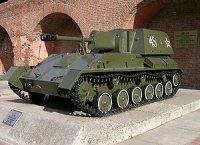SU-76
SU-76 (Stock)
| 35500 Coste |
| 240 PVDurabilidad |
| 10.96 / 13.3 Peso |
- Comandante
- Artillero
- Conductor
- Cargador (Operador de radio)
| 25/15/15Blindaje del casco(frontal/laterales/trasero, mm) |
| 0/10/15Blindaje de la torreta(frontal/laterales/trasero, mm) |
| 80 c.v.Potencia del motor |
| 48 km/hVelocidad punta / velocidad marcha atrás |
| 30 gra/sVelocidad de giro |
| 90 damage |
| 75 mmPenetración media |
| 4.8 Tiempo en completar carga |
| 44 gra/sVelocidad de giro del cañón |
| 240 mAlcance de visión |
| 500 mAlcance de radio |

The SU-76 is a Soviet tier 3 tank destroyer
The SU-76 is the first Russian tank destroyer that combines high penetration, accuracy and view range with a reasonable damage output. Thereby it can be called the first real sniper that a player can reach in World of Tanks. Additionally, it has exceptional camouflage values, allowing it to fire from a covered position and remain hidden from all but the closest enemies. This is very helpful, as the SU-76 has extremely thin armor and will not survive almost any enemy fire.

Cañón
| Nivel | Cañón | Penetración media (mm) | Cadencia de tiro | Dispersión a 100 m | Tiempo de apuntamiento | Experiencia | Peso (t) | |
|---|---|---|---|---|---|---|---|---|
| IV | 57mm ZiS-8S | 75/112/15 | 90/90/110 | 12.5 | 0.41 | 1.7 | 0 | 400 |
| V | 76 mm ZiS-3 | 78/120/20 | 160/160/200 | 6.19 | 0.43 | 2.3 | 3500 | 1255 |
| VI | 57 mm ZiS-2 | 112/189/15 | 90/90/110 | 11.54 | 0.34 | 1.7 | 5050 | 850 |

Motor
| Nivel | Motor | Potencia del motor (c.v.) | Probabilidad de incendio tras disparo | Experiencia | Peso (t) |
|---|---|---|---|---|---|
| II | GAZ-11 | 80 | 20 | 0 | 275 |
| III | GAZ-203 | 140 | 20 | 300 | 362 |
| III | M-80 | 170 | 20 | 360 | 362 |

| Nivel | Suspensión | Límite de carga | Velocidad de giro (gra/s) | Experiencia | Peso (t) |
|---|---|---|---|---|---|
| II | SU-76 | 13.3 | 30 | 0 | 3000 |

Radio
| Nivel | Radio | Alcance de radio (m) | Experiencia | Peso (t) |
|---|---|---|---|---|
| IV | _9R_USSR | 500 | 0 | 80 |
Compatible Equipment
Compatible Consumables
Player Opinion
Pros and Cons
Pros:
- Good penetration and rate of fire (once fully upgraded).
- Good accuracy (once fully upgraded).
- Good hull traverse speed (once fully upgraded).
- Exceptional camouflage values.
- Heavily sloped upper glacis which is deceptively bouncy.
Cons:
- Poor performing when stock
- Narrow traverse gun arc.
- Mediocre aim time.
- Front-mounted engine, vulnerable to damage.
- Thin armor.
Performance
Note that a lot of the pros have the caveat of "once fully upgraded". This is because the stock SU-76 is an absolutely atrocious tank. It cannot mount anything without upgrading the suspension first, not even a Camouflage Net or Binocular Telescope. The rather poor stock engine exacerbates your lack of armor. Upgrading to the M-80 is an excellent first choice, since the cost is very cheap and the engine does not weigh any more than the stock one.. Once the M-80 engine is mounted, the SU-76 becomes quite mobile, although it can have trouble climbing slopes.
The SU-76's strength lies in long range combat, where it can easily kill any opponent it encounters. At the same time, it has nearly no defense against fast moving enemies that can close the distance, and there are many fast tanks in the lower tiers. If it wishes to survive, the SU-76 should always stay behind the frontlines and support other tanks. Ideally, the SU-76 does well from spots overlooking large open areas, but really suffers in city maps where it must play very cautiously.
Early Research
- No modules carry over from the AT-1, and nothing can be mounted until the SU-76M suspension has been researched and mounted.
- Prioritize the M-80 engine after the SU-76M suspension. The GAZ-203 provides negligible benefits, but must be researched to unlock the M-80.
- The 57 mm ZiS-2 is highly recommended as the gun of choice on the SU-76, and should be researched once the M-80 engine has been researched. It is also used on the following SU-85B.
- The 76 mm ZiS-3 is required to unlock the SU-85B.
Historical Info
The SU-76 was based on a lengthened and widened version of the T-70 tank chassis. Its simple construction made it the second-most produced Soviet armored vehicle of World War II, after the T-34 tank.
Crews loved this vehicle for its simplicity, reliability, and ease of use, although it was sometimes nicknamed 'suka' (bitch), 'Suchka' (little bitch) or 'Golozhopiy Ferdinand' (bare-arsed Ferdinand) for its layout which recalled the massive Porsche-designed German tank hunter, and its open rear. One famous crewman was Rem Nikolaevich Ulanov, who is a distinguished German-Soviet War veteran. In his younger days, he was a mechanic-driver and later a commander of an SU-76. He and some other soldiers called their SU-76 Columbina after the female Renaissance Italian Commedia dell'Arte personage.
Design of the SU-76 began in November 1942, when the State Defense Committee ordered the construction of infantry support self-propelled guns armed with the ZiS-3 76.2 mm gun and the M-30 122 mm howitzer. The T-70 chassis was chosen for mounting the ZiS-3 gun and was lengthened, adding one road wheel per side to facilitate better gun mounting.
In the rush for fast completion of the order, a quite unreliable power plant was installed in the first mass produced SU-76s. It utilized two automobile engines (GAZ-202) mounted in "parallel", each track with its own engine. It was found to be difficult for the driver to control the two engines simultaneously. Moreover, strong vibrations led to early failures of engines and transmission units. The vehicle was completely enclosed by armor. After producing 320 SU-76s, mass production was halted in order to fix the problems. Two chief designers at the GAZ plant, N. A. Astrov and A. A. Lipgart, changed the power plant to the reliable T-70 design. The roof of the compartment was removed for better gun servicing. This modified version, called the SU-76M, began mass production in early 1943. The production halt and redesign was the reason for the introduction of the SU-76i (see later) as a temporary replacement for the SU-76.
After the pause, GAZ and two factories in Kirov and Mytishchi produced 13,932 SU-76Ms (the larger part of the order, over 9,000 vehicles, were built solely by GAZ). Mass production of the SU-76M ceased in the second half of 1945. In contemporary accounts, SU-76Ms are often referred to in texts, public radio, and TV broadcasting as SU-76s with the "M" omitted, due to their ubiquity in comparison with the original SU-76s. The SU-76 was the basis for the first Soviet tracked armored anti-aircraft vehicle, the ZSU-37. Mass production of the ZSU-37 was continued after SU-76M production ceased. The SU-76M was withdrawn from Soviet Army service after the Second World War ended.
Variants
- OSU-76 -- Experimental model based on the T-60 tank chassis.
- SU-76 -- Based on a lengthened T-70 tank chassis, with the inferior dual-engine arrangement of earlier T-70s. Only a few were produced, and these were quickly withdrawn from front line service.
- SU-76M -- Main production model.
- SU-76B -- Featured a completely enclosed armoured crew compartment. Only a few were produced.
- ZSU-37 -- Self-propelled anti-aircraft gun, based on the SU-76.
The unrelated SU-76i (1943) was based on the German Panzer III and StuG III chassis, armed with a ZiS-5 76.2 mm gun. About 1,200 of these captured vehicles, many from Stalingrad, were converted at Factory No. 38 by adding a new enclosed superstructure. They were issued to tank and self-propelled gun units starting in autumn 1943.[1]
Combat history
The SU-76M virtually replaced infantry tanks in the close support role. Its thin armor and open top made it vulnerable to antitank weapons, grenades, and small arms. Its low weight and low ground pressure gave it good mobility.
The SU-76M combined three main battlefield roles: light assault gun, mobile anti-tank weapon, and mobile gun for indirect fire. As a light assault gun, the SU-76M had good estimation from Soviet infantrymen (in contrast with their own crews). It had more powerful weapons than any previous light tank for close support and communication between infantry and the SU-76M crew was simple, due to the open crew compartment. This was extremely useful in urban combat where good teamwork between infantry and AFVs is a key to success. Although the open compartment was highly vulnerable to small arms fire and hand grenades, it very often saved the crew's lives in the case of a hit by a Panzerfaust, whose concussion blast would mean death in an enclosed vehicle.
The SU-76M was effective against any medium or light German tank. It could also knock out the Panther tank with a flank shot, but the ZiS-3 gun was not sufficient against Tiger tanks. Soviet manuals for SU-76M crews usually instructed the gunner to aim for the tracks or gun barrel against Tigers. To improve the SU-76M's anti-armor capabilities, armor-piercing composite rigid (APCR) and hollow charge projectiles were introduced. This gave the SU-76M a better chance against heavily armored German vehicles. A low profile, a low noise signature, and good mobility were other advantages of the SU-76M. This was ideal for organizing ambushes and sudden flank or rear strikes in close combat, where the ZiS-3 gun was sufficient against most German armored fighting vehicles.
The maximum elevation angle of the ZiS-3 was the greatest amongst all other Soviet self-propelled guns. The maximum indirect fire distance was nearly 17 km. SU-76Ms were sometimes used as light artillery vehicles (like the German Wespe) for bombardments and indirect fire support. However, the power of the 76.2 mm shells was not sufficient in many cases.
The SU-76M was the single Soviet vehicle able to operate in swamps with minimal support from engineers. During the Belarus liberation campaign in 1944, it was extremely useful for organizing sneak attacks through swamps: bypassing heavy German defenses on firmer ground. Usually, only lightly-armed infantry could pass through large swampy areas. With SU-76M support, Soviet soldiers and engineers could effectively destroy enemy strong-points and continue to advance. The SU-76M had a large number of ammunition types. They included armor-piercing (usual, with ballistic nose and subcaliber hyper-velocity), hollow charge, high explosive, fragmentation, shrapnel, and incendiary projectiles. This made the SU-76M a true multi-purpose light armored fighting vehicle. After World War II, the SU-76 was used by Communist forces in the Korean War.
Surviving examples
Due to the large number of vehicles produced, many SU-76Ms have survived the post-war years, and most of the larger Russian military museums have examples of the SU-76M in their exhibitions. They can also be found at the German-Soviet War monuments or memorials in different Russian, Belarusian, Ukrainian, and Polish cities. There is a nice example at the Muzeul Militar National in Bucharest, Romania.
Sources and External Links
| Light Tanks | IMS-1 • IIBT-2 • IIT-26 • IITetrarch • IIIBT-7 • IIIBT-SV • IIILTP • IIIM3 Light • IIIT-127 • IIIT-46 • IVA-20 • IVValentine II |
| Medium Tanks | IVA-32 • IVT-28 • VMatilda IV • VT-34 • VIT-34-85 • VIT-34-85 Victory • VIIKV-13 • VIIT-34-85 Rudy • VIIT-43 • VIIIT-44 • IXT-54 • XObjeto 140 • XT-62A |
| Heavy Tanks | VChurchill III • VKV-220 Beta-Test • VKV-1 • VIKV-1S • VIKV-2 • VIT-150 • VIIIS • VIIKV-3 • VIIIIS-3 • VIIIIS-6 • VIIIIS-6 Fearless • VIIIKV-5 • VIIIKV-4 • IXIS-8 • IXST-I • XIS-4 • XIS-7 |
| Tank Destroyers | IIAT-1 • IIISU-76 • IVSU-85B • VSU-85 • VSU-85I • VISU-100 • VISU-100Y • VIISU-152 • VIISU-100M1 • VIISU-122-44 • VIIIISU-152 • VIIISU-101 • IXObject 704 • IXSU-122-54 • XObject 263 • XObject 268 |
| USA | IIT18 • IIIT82 • IVM8A1 • IVT40 • VM10 Wolverine • VT49 • VIM18 Hellcat • VIM36 Jackson • VIIT25/2 • VIIT25 AT • VIIIT28 • VIIIT28 Prototype • IXT30 • IXT95 • XT110E3 • XT110E4 |
| UK | IIUniversal Carrier 2-pdr • IIIValentine AT • IVAlecto • VAngry Connor • VAT 2 • VIChurchill Gun Carrier • VIAT 8 • VIIAT 15A • VIIAT 7 • VIIIAT 15 • IXTortoise • XFV215b (183) |
| Germany | IIPanzerjäger I • IIIMarder II • IVHetzer • VStuG III Ausf. G • VIDicker Max • VIJagdpanzer IV • VIIE 25 • VIIE 25 "#1" • VIIJagdpanther • VIIIFerdinand • VIIIJagdpanther II • VIII8,8 cm Pak 43 Jagdtiger • VIIISnowstorm Jagdtiger 8.8 • IXJagdtiger • XJagdpanzer E 100 |
| USSR | IIAT-1 • IIISU-76 • IVSU-85B • VSU-85 • VSU-85I • VISU-100 • VISU-100Y • VIISU-152 • VIISU-100M1 • VIISU-122-44 • VIIIISU-152 • VIIISU-101 • IXObject 704 • IXSU-122-54 • XObject 263 • XObject 268 |
| France | |
| China | |
| Japan | |
| Czechoslovakia | |
| Sweden |


